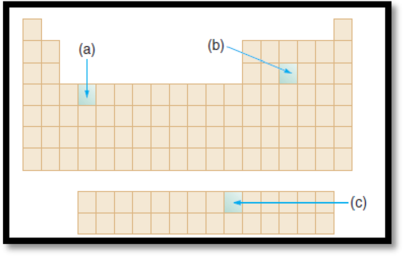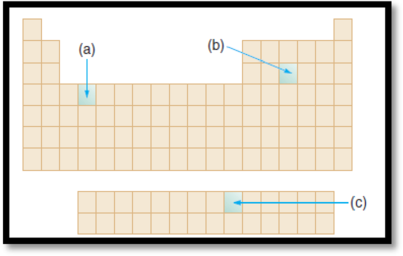
Connect 1-Semester Online Access for Principles of General, Organic & Biochemistry
2nd Edition
ISBN: 9780077633707
Author: Janice Smith
Publisher: Mcgraw-hill Higher Education (us)
expand_more
expand_more
format_list_bulleted
Concept explainers
Question
Chapter 2.4, Problem 2.22P
(a)
Interpretation Introduction
Interpretation:
The name of the element and its symbol, group number, period number, and classification of highlighted element (a) in the figure has to be given.
The given figure is,

Figure 1
(b)
Interpretation Introduction
Interpretation:
The name of the element and its symbol, group number, period number, and classification of highlighted element (b) in the figure has to be given.
The given figure is,

Figure 1
(c)
Interpretation Introduction
Interpretation:
The name of the element and its symbol, group number, period number, and classification of highlighted element (c) in the figure has to be given.
The given figure is,

Figure 1
Expert Solution & Answer
Want to see the full answer?
Check out a sample textbook solution
Students have asked these similar questions
Steps and explanation
Steps and explanations please.
Steps on how to solve. Thank you!
Chapter 2 Solutions
Connect 1-Semester Online Access for Principles of General, Organic & Biochemistry
Ch. 2.1 - Give the symbol for each element. a. calcium, a...Ch. 2.1 - Prob. 2.2PCh. 2.1 - Give the name corresponding to each element...Ch. 2.1 - Locate each element in the periodic table and...Ch. 2.1 - Classify each micronutrient in Figure 2.2 as a...Ch. 2.1 - Identify the elements used in each example of...Ch. 2.1 - Identify the elements in each chemical formula,...Ch. 2.1 - Prob. 2.8PCh. 2.2 - Prob. 2.9PCh. 2.2 - Prob. 2.10P
Ch. 2.2 - Prob. 2.11PCh. 2.2 - Prob. 2.12PCh. 2.2 - Prob. 2.13PCh. 2.3 - Prob. 2.14PCh. 2.3 - Prob. 2.15PCh. 2.3 - Prob. 2.16PCh. 2.3 - Prob. 2.17PCh. 2.3 - Prob. 2.18PCh. 2.4 - Prob. 2.19PCh. 2.4 - Give the period and group number for each element:...Ch. 2.4 - Prob. 2.21PCh. 2.4 - Prob. 2.22PCh. 2.5 - Prob. 2.23PCh. 2.6 - Prob. 2.24PCh. 2.6 - Prob. 2.25PCh. 2.6 - Prob. 2.26PCh. 2.7 - Identify the total number of electrons, the number...Ch. 2.7 - Prob. 2.28PCh. 2.7 - Prob. 2.29PCh. 2.8 - Which element in each pair has the larger atomic...Ch. 2.8 - Which element in each pair has the higher...Ch. 2.8 - Prob. 2.32PCh. 2 - Identify the elements used in each example of...Ch. 2 - Prob. 2.34UKCCh. 2 - Prob. 2.35UKCCh. 2 - Prob. 2.36UKCCh. 2 - Prob. 2.37UKCCh. 2 - Prob. 2.38UKCCh. 2 - Prob. 2.39UKCCh. 2 - Prob. 2.40UKCCh. 2 - Prob. 2.41UKCCh. 2 - Prob. 2.42UKCCh. 2 - Prob. 2.43UKCCh. 2 - Prob. 2.44UKCCh. 2 - Prob. 2.45APCh. 2 - Prob. 2.46APCh. 2 - Prob. 2.47APCh. 2 - Identify the elements in each chemical formula and...Ch. 2 - Prob. 2.49APCh. 2 - Prob. 2.50APCh. 2 - Prob. 2.51APCh. 2 - Prob. 2.52APCh. 2 - Prob. 2.53APCh. 2 - Prob. 2.54APCh. 2 - Prob. 2.55APCh. 2 - Prob. 2.56APCh. 2 - Prob. 2.57APCh. 2 - Prob. 2.58APCh. 2 - The most common isotope of oxygen has a mass...Ch. 2 - Prob. 2.60APCh. 2 - Prob. 2.61APCh. 2 - Prob. 2.62APCh. 2 - Prob. 2.63APCh. 2 - Prob. 2.64APCh. 2 - Prob. 2.65APCh. 2 - Prob. 2.66APCh. 2 - Prob. 2.67APCh. 2 - Prob. 2.68APCh. 2 - Prob. 2.69APCh. 2 - Prob. 2.70APCh. 2 - Prob. 2.71APCh. 2 - Prob. 2.72APCh. 2 - Prob. 2.73APCh. 2 - Prob. 2.74APCh. 2 - Prob. 2.75APCh. 2 - Prob. 2.76APCh. 2 - Prob. 2.77APCh. 2 - Prob. 2.78APCh. 2 - Prob. 2.79APCh. 2 - Prob. 2.80APCh. 2 - Prob. 2.81APCh. 2 - Prob. 2.82APCh. 2 - Prob. 2.83APCh. 2 - Arrange the elements in each group in order of...Ch. 2 - Prob. 2.85APCh. 2 - Prob. 2.86APCh. 2 - Answer the following questions about...Ch. 2 - Prob. 2.88APCh. 2 - Prob. 2.89APCh. 2 - (a) What is the chemical formula for...Ch. 2 - Prob. 2.91CPCh. 2 - Prob. 2.93BTCCh. 2 - Prob. 2.95BTC
Knowledge Booster
Learn more about
Need a deep-dive on the concept behind this application? Look no further. Learn more about this topic, chemistry and related others by exploring similar questions and additional content below.Similar questions
- 3. Name this ether correctly. H₁C H3C CH3 CH3 4. Show the best way to make the ether in #3 by a Williamson Ether Synthesis. Start from an alcohol or phenol. 5. Draw the structure of an example of a sulfide.arrow_forward1. Which one(s) of these can be oxidized with CrO3 ? (could be more than one) a) triphenylmethanol b) 2-pentanol c) Ethyl alcohol d) CH3 2. Write in all the product(s) of this reaction. Label them as "major" or "minor". 2-methyl-2-hexanol H2SO4, heatarrow_forward3) Determine if the pairs are constitutional isomers, enantiomers, diastereomers, or mesocompounds. (4 points)arrow_forward
- In the decomposition reaction in solution B → C, only species C absorbs UV radiation, but neither B nor the solvent absorbs. If we call At the absorbance measured at any time, A0 the absorbance at the beginning of the reaction, and A∞ the absorbance at the end of the reaction, which of the expressions is valid? We assume that Beer's law is fulfilled.arrow_forward> You are trying to decide if there is a single reagent you can add that will make the following synthesis possible without any other major side products: 1. ☑ CI 2. H3O+ O Draw the missing reagent X you think will make this synthesis work in the drawing area below. If there is no reagent that will make your desired product in good yield or without complications, just check the box under the drawing area and leave it blank. Click and drag to start drawing a structure. Explanation Check ? DO 18 Ar B © 2025 McGraw Hill LLC. All Rights Reserved. Terms of Use | Privacy Center | Accessibilityarrow_forwardDon't use ai to answer I will report you answerarrow_forward
- Consider a solution of 0.00304 moles of 4-nitrobenzoic acid (pKa = 3.442) dissolved in 25 mL water and titrated with 0.0991 M NaOH. Calculate the pH at the equivalence pointarrow_forwardWhat is the name of the following compound? SiMe3arrow_forwardK Draw the starting structure that would lead to the major product shown under the provided conditions. Drawing 1. NaNH2 2. PhCH2Br 4 57°F Sunny Q Searcharrow_forward
- 7 Draw the starting alkyl bromide that would produce this alkyne under these conditions. F Drawing 1. NaNH2, A 2. H3O+ £ 4 Temps to rise Tomorrow Q Search H2arrow_forward7 Comment on the general features of the predicted (extremely simplified) ¹H- NMR spectrum of lycopene that is provided below. 00 6 57 PPM 3 2 1 0arrow_forwardIndicate the compound formula: dimethyl iodide (propyl) sulfonium.arrow_forward
arrow_back_ios
SEE MORE QUESTIONS
arrow_forward_ios
Recommended textbooks for you
 Chemistry: Principles and PracticeChemistryISBN:9780534420123Author:Daniel L. Reger, Scott R. Goode, David W. Ball, Edward MercerPublisher:Cengage Learning
Chemistry: Principles and PracticeChemistryISBN:9780534420123Author:Daniel L. Reger, Scott R. Goode, David W. Ball, Edward MercerPublisher:Cengage Learning Chemistry for Today: General, Organic, and Bioche...ChemistryISBN:9781305960060Author:Spencer L. Seager, Michael R. Slabaugh, Maren S. HansenPublisher:Cengage Learning
Chemistry for Today: General, Organic, and Bioche...ChemistryISBN:9781305960060Author:Spencer L. Seager, Michael R. Slabaugh, Maren S. HansenPublisher:Cengage Learning Chemistry: The Molecular ScienceChemistryISBN:9781285199047Author:John W. Moore, Conrad L. StanitskiPublisher:Cengage Learning
Chemistry: The Molecular ScienceChemistryISBN:9781285199047Author:John W. Moore, Conrad L. StanitskiPublisher:Cengage Learning Introductory Chemistry: A FoundationChemistryISBN:9781337399425Author:Steven S. Zumdahl, Donald J. DeCostePublisher:Cengage Learning
Introductory Chemistry: A FoundationChemistryISBN:9781337399425Author:Steven S. Zumdahl, Donald J. DeCostePublisher:Cengage Learning Chemistry & Chemical ReactivityChemistryISBN:9781133949640Author:John C. Kotz, Paul M. Treichel, John Townsend, David TreichelPublisher:Cengage Learning
Chemistry & Chemical ReactivityChemistryISBN:9781133949640Author:John C. Kotz, Paul M. Treichel, John Townsend, David TreichelPublisher:Cengage Learning

Chemistry: Principles and Practice
Chemistry
ISBN:9780534420123
Author:Daniel L. Reger, Scott R. Goode, David W. Ball, Edward Mercer
Publisher:Cengage Learning

Chemistry for Today: General, Organic, and Bioche...
Chemistry
ISBN:9781305960060
Author:Spencer L. Seager, Michael R. Slabaugh, Maren S. Hansen
Publisher:Cengage Learning

Chemistry: The Molecular Science
Chemistry
ISBN:9781285199047
Author:John W. Moore, Conrad L. Stanitski
Publisher:Cengage Learning

Introductory Chemistry: A Foundation
Chemistry
ISBN:9781337399425
Author:Steven S. Zumdahl, Donald J. DeCoste
Publisher:Cengage Learning


Chemistry & Chemical Reactivity
Chemistry
ISBN:9781133949640
Author:John C. Kotz, Paul M. Treichel, John Townsend, David Treichel
Publisher:Cengage Learning
NEET Chemistry | Group 14 Carbon Family | Theory & Problem Solving | In English | Misostudy; Author: Misostudy;https://www.youtube.com/watch?v=enOGIrcHh54;License: Standard YouTube License, CC-BY